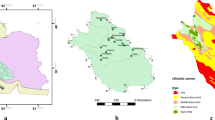Abstract
The main objective of this study is to investigate the joint distribution of rainfall severity and rainfall duration in the state of Victoria, Australia, based on monthly rainfall data from selected rain-gauge stations which are located in the north-eastern and south-western parts of the state, during the period from 1950 to 2010. Traditional approach for considering the joint distribution of rainfall characteristics using standard bivariate modeling presents some limitations that can be circumvented by using Copula models. Archimedean and extreme-value copulas will be used to obtain the bivariate distribution of rainfall severity and duration. The Standard Precipitation Index (SPI), which is employed extensively to quantify rainfall severity, will be discussed in detail. Several goodness of fit tests will be performed to find the best fitting copulas and the results will be summarized. The final fitted copulas will then be applied to obtain the joint and conditional return periods from a minimum of two years to one hundred years of rainfall events in Victoria.







Similar content being viewed by others
References
Australia Bureau of Meteorlogy (BOM) (2010) Website
Abdul Rauf U, Zeephongsekul P (2011) Modelling rainfall severity and duration in north-eastern victoria using copulas. Proceedings of the 19th international congress on modelling and simulation, Perth
Bonaccorso B, Cancelliere A, Rossi G (2003) An analytical formulation of return period of drought severity. Stoch Environ Res Risk Assess 17:157–174
Demarta S, McNeil AJ (2005) The t copula and related copulas. Int Stat Rev 73(1):111–129
Edward D, McKee T (1997) Characteristics of 20th century drought in united state at multiple time scales. Climatology Report 97-2. Colorado State University, Fort Collins
Genest C, Favre A (2007) Everything you always wanted to know about copula modeling but were afraid to ask. J Hydrol Eng 12(4):347–368
Genest C, Rmillard B, Beaudoin D (2009) Goodness-of-fit tests for copulas: a review and a power study. Insur Math Econ 44(2):199–213
Genest C, Kojadinovic I, Neslehova J, Yan J (2011) Goodness-of-fit tests for bivariate extreme-value copulas. Bernoulli 17(1):253–275
Hofert M, Kojadinovic I, Maechler M, Yan J (2012) Copula: multivariate dependence with Copulas. http://CRAN.R-project.org/package=copula, r package version 0.999-5
Joe H (1997) Multivariate models and dependence concepts. Chapman and Hall, London
Kao SC, Govindaraju RS (2008) Trivariate statistical analysis of extreme rainfall events via the plackett family of copulas. Water Resour Res 44:1–19
Kao SC, Govindaraju RS (2010) A copula-based joint deficit index for droughts. J Hydrol 380(1–2):121–134
McKee T, Doesken N, Kleist J (1993) The relationship of drought frequency and duration to time scales. 8th Conference on Applied Climatology, Anaheim, California, pp 179–184
McKee T, Doesken N, Kleist J (1995) Drought monitoring with multiple time scales. 9th Conference on Applied Climatology, Boston, Massachussetts, pp 233–236
Mirabbasi R, Fakheri-Fard A, Dinpashoh Y (2012) Bivariate drought frequency analysis using the copula method. Theor Appl Climatol 108:191–206
Mohan S, Sahoo PK (2008) Stochastic simulation of droughts. part 1: point droughts. Hydrol Process 22(6):854–862
Nelsen RB (2006) Introduction to Copulas. Lecture notes statistics, vol 139, 2nd edn. Springer-Verlag, New York
Pickands III J (1981) Mutivariate extreme value distributions. In: Proceedings of the 43rd Session of the International Statistical Institute, Bull. Inst. Internat. Statist., Buenos Aires, 859-878, vol 2, pp 894–902
Reddy M, Ganguli P (2012) Application of copulas for derivation of drought severitydurationfrequency curves. Hydrol Process 26(11):1672–1685
Salvadori G, De Michele C, Durante F (2011) On the return period and design in a multivariate framework. Hydrol Earth Syst Sci 15(11):3293–3305
Serinaldi F, Bonaccorso B, Cancelliere A, Grimaldi S (2009) Probabilistic characterization of drought properties through copulas. Phys Chem Earth, Parts A/B/C 34(10–12):596–605
Shiau J (2006) Fitting drought duration and severity with two-dimensional copulas. Water Resour Manag 20:795–815
Shiau J, Shen H (2001) Recurrence analysis of hydrologic droughts of differing severity. J Water Resour Plann Manag 127(1):30–40
Shiau JT (2003) Return period of bivariate distributed extreme hydrological events. Stoch Environ Res Risk Assess 17:42–57
Sklar A (1959) Fonctions derépartition à n dimensions et leurs marges. Publ Inst Statist Univ Paris 8:229–231
Thom H (1966) Some methods of climatological analysis. World Meteorological Organization Technical Note 81
Vandenberghe S, van den Berg MJ, Gräler B, Petroselli A, Grimaldi S, De Baets B, Verhoest NEC (2012) Joint return periods in hydrology: a critical and practical review focusing on synthetic design hydrograph estimation. Hydrol Earth Syst Sci Discuss 9(5):6781–6828
Xi Chen S, Huang T (2007) Nonparametric estimation of copula functions for dependence modelling. Can J Stat 35:265–282
Zhang L, Singh VP (2007) Bivariate rainfall frequency distributions using archimedean copulas. J Hydrol 332(1–2):93–109
Acknowledgments
The authors sincerely acknowledge Bureau of Meteorology, Australia (BOM) for providing the complete historical precipitation data that been used in this study. The authors would are like to thank the anonymous reviewer for valuable comments, suggestions and careful reading of paper which have led to a much improved version.
Author information
Authors and Affiliations
Corresponding author
Rights and permissions
About this article
Cite this article
Abdul Rauf, U.F., Zeephongsekul, P. Copula based analysis of rainfall severity and duration: a case study. Theor Appl Climatol 115, 153–166 (2014). https://doi.org/10.1007/s00704-013-0877-1
Received:
Accepted:
Published:
Issue Date:
DOI: https://doi.org/10.1007/s00704-013-0877-1




